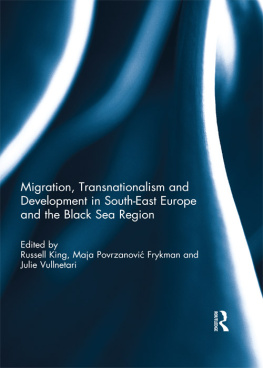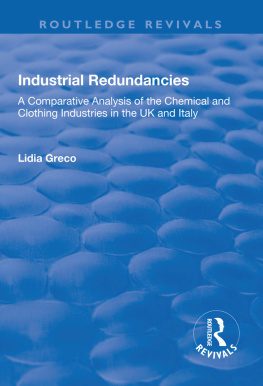ROUTLEDGE LIBRARY EDITIONS: ECONOMIC GEOGRAPHY
Volume 7
THE INDUSTRIAL GEOGRAPHY OF ITALY
THE INDUSTRIAL GEOGRAPHY OF ITALY
RUSSELL KING
First published in 1985
This edition first published in 2015
by Routledge
2 Park Square, Milton Park, Abingdon, Oxon, OX14 4RN
and by Routledge
711 Third Avenue, New York, NY 10017
Routledge is an imprint of the Taylor & Francis Group, an informa business
1985 Russell King
All rights reserved. No part of this book may be reprinted or reproduced or utilised in any form or by any electronic, mechanical, or other means, now known or hereafter invented, including photocopying and recording, or in any information storage or retrieval system, without permission in writing from the publishers.
Trademark notice: Product or corporate names may be trademarks or registered trademarks, and are used only for identification and explanation without intent to infringe.
British Library Cataloguing in Publication Data
A catalogue record for this book is available from the British Library
ISBN: 978-1-138-85764-3 (Set)
eISBN: 978-1-315-71580-3 (Set)
ISBN: 978-1-138-85440-6 (Volume 7)
eISBN: 978-1-315-72114-9 (Volume 7)
Publishers Note
The publisher has gone to great lengths to ensure the quality of this reprint but points out that some imperfections in the original copies may be apparent.
Disclaimer
The publisher has made every effort to trace copyright holders and would welcome correspondence from those they have been unable to trace.
THE INDUSTRIAL GEOGRAPHY OF ITALY
Russell King
1985 Russell King
Croom Helm Ltd, Provident House, Burrell Row,
Beckenham, Kent BR3 1AT
Croom Helm Australia Pty Ltd, Suite 4, 6th Floor
64-76 Kippax Street, Surry Hills, NSW 2010, Australia
British Library Cataloguing in Publication Data
King, Russell
The industrial geography of Italy (Croom Helm industrial geography series)
1. Italy Industries 2. Italy Economic conditions 1976
I. Title
338.0945 HC305
ISBN 0-7099-1501-2
Printed and bound in Great Britain
CONTENTS
Ai geografi italiani
To the geographer, Italy presents an ambivalent picture. The Alps, the Po plains, the peninsula and the islands create an illusion of unity, neatly defined by sea and mountain-crest: a geographical expression, to quote Metternichs famous phrase. Yet this physical illusion must be tempered by political reality and a lack of internal cohesion. In 1848, year of European revolutions, Italy comprised seven sovereign states. Whereas other European countries have been unified states for hundreds of years, Italy was a latecomer to the European family of nation-states, completing its unification only in 1870. It thus came into the industrial revolution cautiously, fragmented and still paying homage to a series of foreign masters. Along with Germany, Austria and Switzerland, it broke the barriers constraining industrial expansion in a kind of second round of European development. Not until after the First World War did absolute numbers engaged in agricultural employment begin to fall; not until after the Second World War were there more workers in industry than in farming. Italy has, rather uniquely, become one of the worlds ten leading industrial powers while at the same time the proportion of the workforce engaged in agriculture remains higher than in any other Common Market country except Greece and Ireland.
Since 1945 Italy has made great strides towards compensating for early industrial deficiencies. In the post-war period the Italian economy has consistently had one of the highest growth rates of any industrial country. Its average annual growth rate of around 6 per cent during 195171 was bettered only by Japan amongst the worlds major capitalist countries. Yet the Italian industrial experience contains a number of recently-manifest cautionary lessons which are of great potential relevance to other semi-industrialised or recently-industrialised countries. Rapid industrial growth has frequently been compromised by a painfully inefficient and cumbersome bureaucracy. In many fields policy-making structures are archaic. The process of industrial decision-making is at best labyrinthine, at worst corrupt. There are positive lessons to be learnt too. How to live with continuing inflation is one. Much can be learnt about the dynamics of enterprise by studying the small firms of Prato or the rural Veneto, or the merchants of medieval Florence, or a moribund modern giant like Montedison, or the loss-making nationalised industries of the IRI group. The Mezzogiorno provides one of the best object-lessons in European regional policy.
The way in which a lagging polity trails far behind an economy and a society in flux is symptomatic of a fundamental Italian malaise: imbalance and instability. There is an overconcentration of industry in the Italian industrial triangle of Milan-Turin-Genoa. Polarisation between big and small producers seems to be worsening. Particularly alarming are certain persisting social imbalances. While the dynamism of the industrial economy, particularly in the 1950s and 1960s, led to rapidly rising living standards and the spread of the consumer society to most parts of the country, social services have languished. For this, Italians paid the price in the 1970s and 1980s: overcrowded schools, universities and hospitals; unchecked urban growth and land speculation; a severe shortage of low-cost housing and urban recreational space; the menace of urban terrorism; and mass unemployment.
A study of Italian industrial geography, like that of most countries, admits three basic approaches: temporal, sectoral and regional. These have been used as the basic framework of this book. Part One: Background to Industrial Development in Italy, is essentially chronological. After a brief examination of the physical and human resource base, Italys uniquely fluctuating historical pattern of industrialisation is traced. From a position of world industrial dominance in classical and medieval times (insofar as one can talk of industry in these eras), Italy slumped to relative obscurity by the seventeenth century. Post-unification industrial development has been concentrated in two main periods: from the late 1890s until 1913; and since 1945. Part Two examines the major industrial sectors in turn: power and infrastructures, textiles, metallurgy and engineering and chemicals. For each, the analysis is in terms of origin, structure and spatial distribution. The third part of the book deals with regional contrasts. Here three major industrial vignettes are painted: for the North, Centre and South.
In writing this study I have used a wide range of published materials, mostly in English and Italian, drawn from a variety of disciplines in addition to geography. A glance at the Bibliography reveals the richness of Italian geographical literature and the diversity of non-Italian scholarly studies particularly in the field of economic history which are relevant to Italian industrial development. I have also benefited from the detailed statistical publications of the Italian










